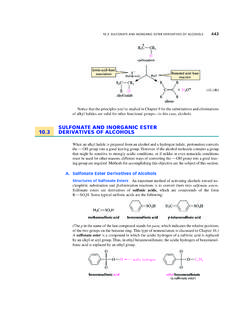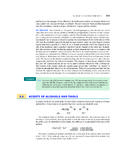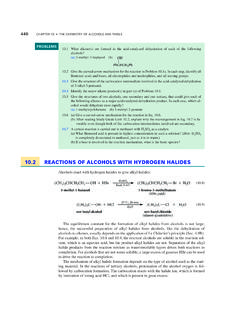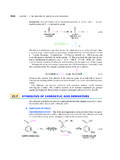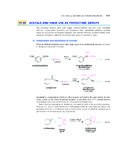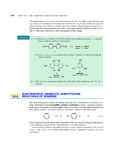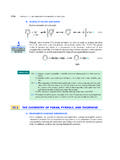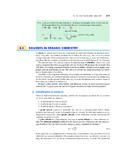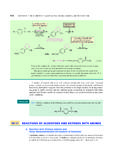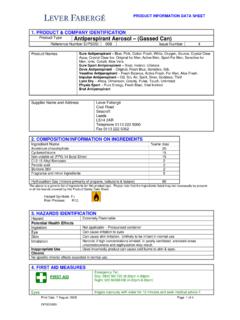Transcription of 1122 CHAPTER 23 • THE CHEMISTRY OF AMINES
1 1122 CHAPTER 23 THE CHEMISTRY OF AMINES alkylamines, this resonance occurs at rather small chemical shift typically around d1. Inaromatic AMINES , this resonance is at greater chemical shift, as in the second of the the OH protons of alcohols, phenols, and carboxylic acids, the NH protons of aminesunder most conditions undergo rapid exchange (Secs. and ). For this reason, split-ting between the amine NLH and adjacent CLH groups is usually not observed. Thus, inthe NMR spectrum of diethylamine, the NLH resonance is a singlet rather than the triplet ex-pected from splitting by the adjacentLCH2 Lprotons.
2 In some amine samples, the NLHresonance is broadened and, like the OLH proton of alcohols, it can be obliterated from thespectrum by exchange with D2O (the D2O shake, p. 611).The characteristic 13C NMR absorptions of AMINES are those of the a-carbons the carbonsattached directly to the nitrogen. These absorptions occur in the d30 50 chemical-shift expected from the relative electronegativities of oxygen and nitrogen, these shifts aresomewhat less than the a-carbon shifts of AND ACIDITY OF AMINESA. Basicity of AminesAmines, like ammonia, are strong enough bases that they are completely protonated in diluteacid salts of protonated AMINES are called ammonium ammonium salts of simplealkylamines are named as substituted derivatives of the ammonium ion.
3 Other ammonium saltsare named by replacing the final ein the name of the amine with the suffix benzoate(aniline + ium)(CH3)2NH2Cl_|NH3|cLL L_OCOPhS( )HmethylammoniumchloridemethylamineLClLH 3 CNH21H2O++LH3 CNH3Cl_| the compound that has an M +1 ion at m z=136 in its CI mass spectrum, an IRabsorption at 3279 cm_1, and the following NMR spectrum: (1H, s), (3H, t, J=7Hz), (2H, q, J=7Hz), (2H, s), (5H, apparent s). A compound has IR absorptions at 3400 3500 cm_1and the following NMR (6H, s), (3H, s), (broad, exchanges with D2O), (2H, s).
4 To whichone of the following compounds do these spectra belong? Explain.(1) 2,4-dimethylbenzylamine (2) 2,4,6-trimethylaniline(3) N,N-dimethyl-p-methylaniline (4) 3,5-dimethyl-N-methylaniline(5) 4-ethyl-2, Explain how you could distinguish between the two compounds in each of the following setsusing only13C NMR spectroscopy.(a) 2,2-dimethyl-1-propanamine and 2-methyl-2-butanamine(b)trans-1,2-cycloh exanediamine and trans-1, 12/8/08 1:22 PM Page BASICITY AND ACIDITY OF AMINES1123 Always remember that ammonium salts are fully ionic compounds.
5 Although ammoniumchloride is often written as NH4Cl, the structure is more properly represented as | the NLH bonds are covalent, there is no covalent bond between the nitrogen andthe chlorine. (A covalent bond would violate the octet rule.)Recall that the basicity of any compound, including an amine, is expressed in terms of thepKaof its conjugate acid (Sec. ). The higher the pKaof an ammonium ion, the more basicis its conjugate-base amine. (A discussion of the relationship between basicity constants Kband dissociation constants Kais given in Study Guide Link )B.
6 Substituent Effects on Amine BasicityThe pKavalues for the conjugate acids of some representative AMINES are given in Table this table shows, the exact basicity of an amine depends on its structure. Four factors influ-ence the basicity of AMINES ; these are the same effects that influence the acid base propertiesof other compounds. They are:1. the effect of alkyl substitution2. the polar effect3. the resonance effect4. the effect of chargeRecall that the pKaof an ammonium ion, like that of any other acid, is directly related to thestandard free-energy difference DGa between it and its conjugate base by the following equa-tion (Eq.)
7 , p. 112 ).DGa = (pKa)( )Basicities of Some AMINES (Each pKavalue is for the dissociation of the corresponding conjugate-acid ammonium ion.) (CH3) (CH3) (C2H5) (C2H5) (CH3) )LH3 CNH2$LLNH2H3 CLClNH2)LClNH2$LLClNH2LO2 NNH2$LLO2 NNH2 TABLE 12/8/08 1:22 PM Page 11231124 CHAPTER 23 THE CHEMISTRY OF AMINESThe effect of a substituent group on pKacan be analyzed in terms of how it affects the energyof either an ammonium ion or its conjugate-base amine, as shown in Fig. For example,if a substituent stabilizes an amine more than it stabilizes the conjugate-acid ammonium ion(Fig.
8 , the standard free energy of the amine is lowered, DGa is decreased, and the pKaof the ammonium ion is reduced; that is, the amine is less basic than the amine without thesubstituent. If a substituent stabilizes the ammonium ion more than its conjugate-base amine(Fig. ), the opposite effect is observed: the pKais increased, and the amine basicity isalso first the effect of alkyl substitution. Most common alkylamines are somewhatmore basic than ammonia in aqueous solution:pKain aqueous solution:However, the increase in basicity that results from substitution of one hydrogen of ammoniaby a methyl group is reversed as the number of alkyl substituents is increased to three.
9 Howcan we explain this turnaround in amine basicity?Two o p p o s i n g fa c t o r s a r e a c t u a l l y a t wo r k h e r e . T h e fi r s t i s t h e t e n d e n cy o f a l ky l g r o u p s t ostabilize charge through apolarizationeffect. The electron clouds of the alkyl groups distort soas to create a net attraction between them and the positive charge of the ammonium ion:Because the ammonium ion is stabilized by this effect, its pKais increased (Fig. ). Thiseffect is evident in the gas-phasebasicities of AMINES . In the gas phase, the acidity of ammo-nium ions decreases regularly with increasing alkyl substitution:Gas-phase acidity:The same polarization effect also operates in the gas-phase acidity of alcohols (Sec.)
10 , ex-cept in the opposite direction. In other words, the polarization of alkyl groups can act to stabi-lize eitherpositive or negative charge. In the presence of a positive charge, as in ammoniumions, electrons polarize towardthe charge; in the presence of a negative charge, as in alkoxideions, they polarize away fromthe charge. We might say that electron clouds are like somepoliticians: they polarize in whatever way is necessary to create the most favorable situation.(See Further Exploration for a more extensive discussion.)The second factor involved in the effect of alkyl substitution on amine basicity must be asolvent effect,because the basicity order of AMINES in the gas phase (Eq.)

